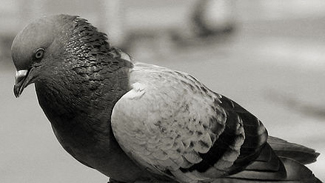Study on the disease of bird fancier's lung

Bird fancier's lung (BFL) is one of the most common types of hypersensitivity pneumonitis. Nevertheless, the criteria for diagnosing this condition are not standardized. The current study is an in-depth investigation into the clinical characteristics of BFL in the largest series examined for this purpose by a single group, to our knowledge, taking into account the acute, subacute, or chronic clinical presentation.
From 1977 to 2003, BFL was diagnosed in 86 patients using a homogeneous protocol. Data from the clinical history and physical examination were analyzed, as well as the results from the following complementary examinations: laboratory analyses, specific serum IgG antibodies determination, chest X-ray, chest computed tomography (CT), pulmonary function testing, immediate hypersensitivity skin testing, delayed cutaneous hypersensitivity testing, bronchofibroscopy with bronchoalveolar lavage (BAL) and/or transbronchial biopsy, bronchial challenge testing, and surgical lung biopsy. In addition, clinical and epidemiologic characteristics were determined in a control group of 60 pigeon breeders who did not meet the diagnostic criteria of BFL.
Eighty-six patients (21 men and 65 women) with a mean age of 47 years were studied. Seven (8%) patients were younger than 15 years of age at the time of the diagnosis. In 3 cases, the disease was caused by exposure to feather-filled bedding. Nearly I in 5 patients was diagnosed in the chronic phase of the disease. The mean diagnostic delay was 1.6 years overall, and 3.2 years in patients diagnosed in the chronic phase of the disease. Among the 17% of patients with chronic disease, the mean interval from initiation of exposure to diagnosis was 16 years, a higher value than in the acute or subacute presentation forms. Dyspnea and cough were the most common clinical symptoms (98% and 82%, respectively), and nearly 25% had grade III or IV dyspnea at diagnosis. Only 18% of patients experienced chest tightness, a symptom classically considered to be frequent in this condition. Erythrocyte sedimentation rate was elevated (>30 mm/h) in 44% of patients. Urinary calcium was elevated in 20% of patients. Angiotensin-converting enzyme was not elevated in any of the patients in which it was measured. Lactate dehydrogenase increases were found in 51% of patients. Specific IgG antibodies to avian antigens were documented in 92% of BFL patients, but also in 87% of pigeon breeder controls.
The most frequent radiologic finding was an interstitial pattern in 79% of patients. Common chest CT features were ground glass areas (68%) and a mosaic pattern (61%); areas of emphysema were, found in 7/41 (17%) patients' 5 of whom had never smoked. Two patients had a CT pattern of pulmonary fibrosis indistinguishable from idiopathic pulmonary fibrosis. Immediate hypersensitivity skin testing with bird sera and pigeon bloom was positive in 78% and 100% of BEL patients, respectively, and in 64% and 88% of control pigeon breeders, respectively. Almost one-third of the patients (29%) presented an anergic response on delayed cutaneous hypersensitivity testing. Restrictive ventilatory impairment was the most frequent functional pattern (77%), although 9% and 4%, showed a pure obstructive and mixed pattern, respectively. The carbon monoxide diffusing capacity was decreased (<80% of the predicted value) in 85% of cases. Forty-one percent of patients had PaO2 <60 mm Hg at diagnosis when blood gas analysis was performed. Lymphocytosis (>20% lymphocytes) was documented in 83% of patients who under-went BAL, with a similar frequency in the 3 presentation forms: 70% acute, 89% subacute, and 85% chronic. In addition, inversion of the CD4/CD8 ratio (<1) was observed in 62% of the patients, but 38% of cases showed a CD4 predominance. The characteristic triad of histopathologic findings in hypersensitivity pneumonitis was found in only 9% of patients undergoing transbronchial biopsy, but at least I of these findings was seen in 69%. Surgical lung biopsy was undertaken in 14/86 (16%) patients; the complete triad was observed in 50% and at least I finding in 100%. In 54/86 (63%) patients, the diagnosis was confirmed by bronchial challenge testing, a test with a sensitivity of 92% and specificity of 100%.
BFL is a potentially severe disease that can progress to respiratory failure secondary to pulmonary fibrosis or chronic obstructive pulmonary disease, as a form of chronic occupational respiratory disease. Respiratory symptoms in exposed patients, including children and adults who have only I pet bird at home, should raise the suspicion of BFL. Diagnosis in the chronic phase is frequent, and the delay to diagnosis was greatest in these cases. Elevated urinary calcium, lactate dehydrogenase, and erythrocyte sedimentation rate in a bird fancier may constitute a combined marker for suspected BFL. Chest CT frequently discloses emphysema and a pattern of idiopathic pulmonary fibrosis in some patients. An anergic response on delayed cutaneous hypersensitivity testing is not infrequent. The presentation with respiratory failure and the predominance of CD4 T lymphocytes in some patients' BAL are both remarkable. Lymphocytosis on BAL also persists in the chronic phase of the disease. Bronchial challenge testing has a high diagnostic yield, and surgical lung biopsy is not needed to reach the final diagnosis in the vast majority of cases.
References
"Bird fancier's lung - A series of 86 patients". Morell, F; Roger, A; Reyes, L; Cruz, MJ; Murio, C; Munoz, X. MEDICINE, 87 (2): 110-130 MAR 2008

